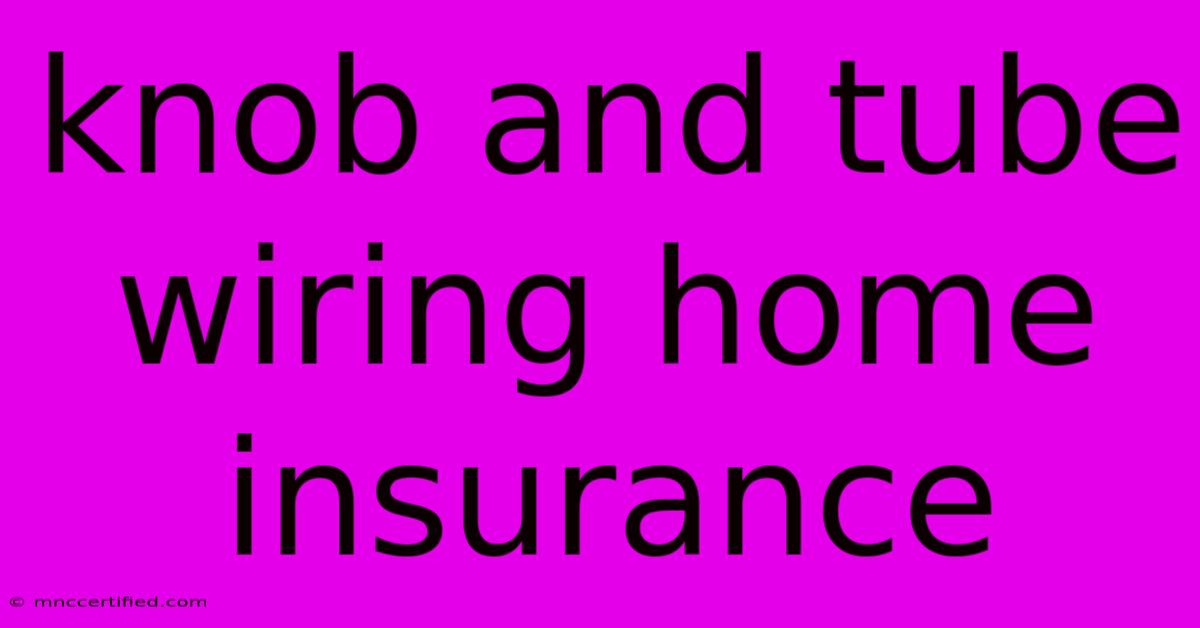Knob And Tube Wiring Home Insurance

Table of Contents
Knob and Tube Wiring: Understanding the Impact on Home Insurance
Owning a historic home with charming architectural details is a dream for many. However, these older properties often come with an older electrical system – knob and tube wiring. While this wiring method was once the standard, it's now considered outdated and potentially hazardous. This raises a crucial question for homeowners: how does knob and tube wiring affect home insurance?
The Risks of Knob and Tube Wiring
Knob and tube wiring, common in homes built before the 1940s, uses porcelain knobs and tubes to insulate wires. While it was considered safe at the time, this system has several drawbacks:
- Fire Hazard: The lack of modern insulation and the open wiring configuration increase the risk of electrical fires. Overheating, short circuits, and rodent damage can all lead to dangerous situations.
- Limited Capacity: Knob and tube wiring often lacks the capacity to handle modern electrical demands, increasing the risk of overloaded circuits and potential fires.
- Difficult to Modify: Upgrading or expanding the electrical system can be challenging and expensive due to the complexity of working with knob and tube wiring.
Impact on Home Insurance
Insurance companies are acutely aware of the risks associated with knob and tube wiring. Consequently, owning a home with this type of wiring can significantly impact your home insurance:
- Higher Premiums: You'll likely face higher insurance premiums compared to homes with updated wiring systems. This is because insurance companies consider knob and tube wiring a significant risk factor.
- Limited Coverage: Some insurance companies may refuse to insure homes with knob and tube wiring altogether. Others may offer limited coverage, potentially excluding fire damage or requiring specific mitigation measures.
- Increased Difficulty in Finding Coverage: It may be more challenging to find insurance providers willing to cover a home with knob and tube wiring, requiring extensive research and comparison.
What to Do If Your Home Has Knob and Tube Wiring
If you own a home with knob and tube wiring, it's crucial to take action to mitigate the risks:
- Have It Inspected: Schedule a professional electrical inspection to evaluate the condition of your wiring and identify any potential safety hazards.
- Consider Rewiring: The safest and most effective solution is to rewire your home with modern electrical systems. While costly, this investment significantly reduces your insurance risk and enhances the overall safety of your home.
- Implement Safety Measures: If rewiring isn't immediately possible, you can implement safety measures to reduce risks, such as:
- Avoid Overloading Circuits: Distribute electrical loads carefully to prevent overloading circuits.
- Use GFCIs: Install ground fault circuit interrupters (GFCIs) in areas with high moisture exposure.
- Maintain Wiring Regularly: Conduct regular inspections and address any wiring issues promptly.
By taking these steps, you can minimize the impact of knob and tube wiring on your home insurance and ensure the safety of your family and property.
The Bottom Line
Knob and tube wiring presents a significant risk factor for homeowners and directly influences home insurance premiums and coverage options. Understanding the potential consequences and taking appropriate action can help you protect your home, family, and finances. While rewiring is the optimal solution, other measures can mitigate risks until a full upgrade is feasible. By being proactive and addressing the challenges posed by knob and tube wiring, you can safeguard your investment and enjoy peace of mind in your historic home.

Thank you for visiting our website wich cover about Knob And Tube Wiring Home Insurance. We hope the information provided has been useful to you. Feel free to contact us if you have any questions or need further assistance. See you next time and dont miss to bookmark.
Featured Posts
-
Cost Of An Endoscopy With Insurance
Nov 13, 2024
-
Whites Seek Next Stage Evatt Puts Friendship Aside
Nov 13, 2024
-
Singlers Post Prompts Loves Call For Support
Nov 13, 2024
-
Reports Trump To Name Rubio Secretary Of State
Nov 13, 2024
-
Leadbeater Mps Views On Assisted Dying Bill
Nov 13, 2024